- News
- Reviews
- Bikes
- Accessories
- Accessories - misc
- Computer mounts
- Bags
- Bar ends
- Bike bags & cases
- Bottle cages
- Bottles
- Cameras
- Car racks
- Child seats
- Computers
- Glasses
- GPS units
- Helmets
- Lights - front
- Lights - rear
- Lights - sets
- Locks
- Mirrors
- Mudguards
- Racks
- Pumps & CO2 inflators
- Puncture kits
- Reflectives
- Smart watches
- Stands and racks
- Trailers
- Clothing
- Components
- Bar tape & grips
- Bottom brackets
- Brake & gear cables
- Brake & STI levers
- Brake pads & spares
- Brakes
- Cassettes & freewheels
- Chains
- Chainsets & chainrings
- Derailleurs - front
- Derailleurs - rear
- Forks
- Gear levers & shifters
- Groupsets
- Handlebars & extensions
- Headsets
- Hubs
- Inner tubes
- Pedals
- Quick releases & skewers
- Saddles
- Seatposts
- Stems
- Wheels
- Tyres
- Health, fitness and nutrition
- Tools and workshop
- Miscellaneous
- Tubeless valves
- Buyers Guides
- Features
- Forum
- Recommends
- Podcast
news
 Tour de France 2014 presentation.png
Tour de France 2014 presentation.pngTour de France 2014 route unveiled
Yorkshire, which hosts the opening two stages of next year’s 101st Tour de France, took centre stage at today’s presentation of the route in Paris.
There is a realistic prospect of a sprint finish to the opening stage of the Tour from Leeds to Harrogate, and no-one will have a greater incentive than the race’s most successful ever sprinter, Mark Cavendish: the stage finishes in his mother’s home town.
With the big mountains saved for the final third of the racing – although you shouldn't discount the ability of the Vosges climbs to split the field – it could be an unpredictable opening fortnight with the yellow jersey changing hands several times following what race director Christian Prudhomme described in March as "the toughest Grand Départ since the Pyrenees in 1979." In his reaction to the route (which you can read here in full) Sir Dave Brailsford reckoned it was a parcours that would enourage breaks and be difficult for one team to control, no prizes for guessing which team he meant.

A star-studded audience, including this year’s winner of the yellow jersey, Team Sky’s Chris Froome, learnt that cobbles will feature early on after the race crosses the Channel.
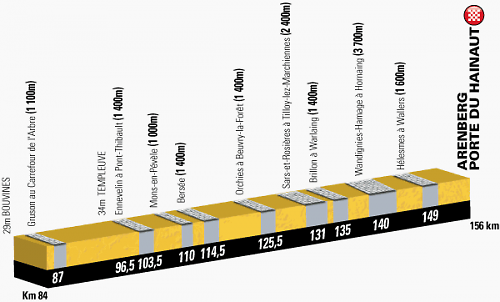
Stage 5 has nine sections of cobbles, the longest at 3,700m
That’s good news for Classics specialists looking for a stage win, but a much less appealing prospect for those with their eyes on the overall victory, who will be mindful that the sections of pavé on Stage 5 from Ypres to Arenberg Porte du Hainaut could easily see their race end through a crash.
After the cobbles the race heads towards the Vosges, and first proper tests for the climbers will come there, with summit finishes above the ski resort of Gérardmer and also on the famous Planche des Belles Filles.
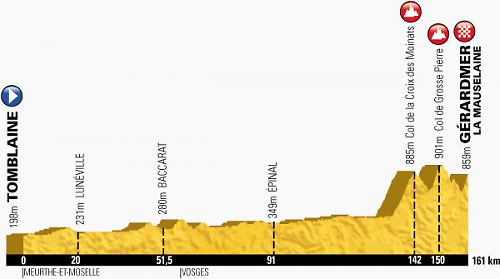
The Gérardmer stage doesn't look that tough as a whole stage but those hills at the end have some nasty surprises in store. The second kilometre of the climb to Col de Grosse Pierre averages 11.3%, and tthe final grind to La Mauselaine is nearly 2km at an average of over 10%. Not enough to decide the race, for sure, but steep and long enough to open some gaps.
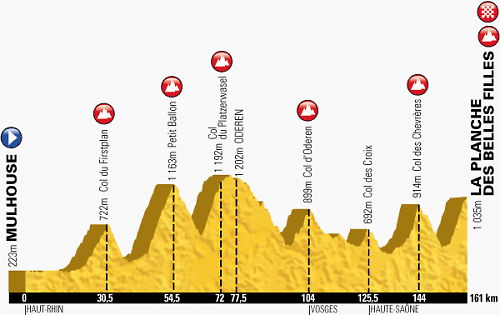
La Planche des Belles Filles comes at the end of a day that features six other significant climbs, and although it's less than 6km long that final climb is murderously steep, averaging 8.5% with a 20% ramp right at the finish. The climb before it, the Chevrères, has a kilometre at nearly 15%.
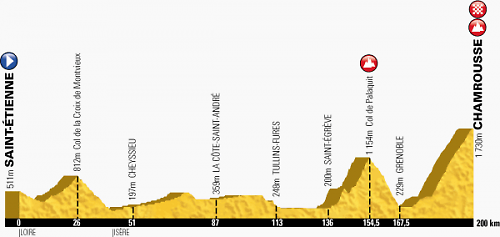
Into the Alps, the stage from Saint Étienne finishes with the climb to Chamrousses which is over 18km long with some steep sections at the bottom. Further up it's more of a tempo climb so expect to see fireworks at the bottom with the more explosive climbers trying to make a break stick.
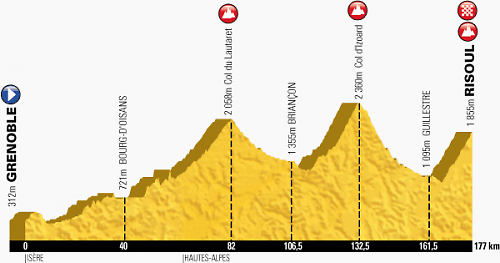
The climb to Risoul comes after the Lautaret and Izoard have been crested, both over 2,000m. Depending on the state of the race, Grenoble - Risoul looks a good bet for a mountain break to stay away, with the steady final climb less likely to see the big guns going after one another.
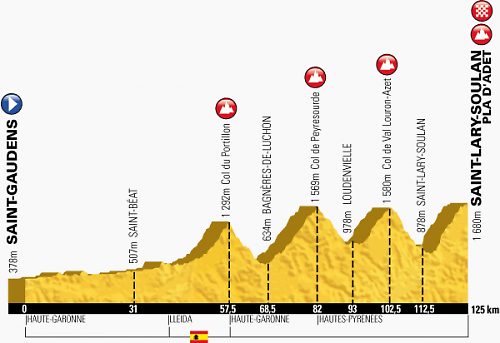
The final climb to Pla d'Adet on stage 17 starts less than 115km into the racing; at 125km overall this stage is the shortest with the exception of the individual time trial. It's no walk in the park though, with three tough cols before that final climb steeples out of the valley at an average of 10% for the first 3km.
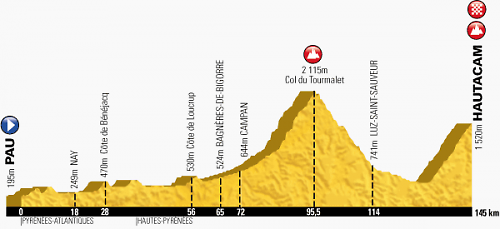
Pau to Hautacam is the Etape du Tour stage, and even before tackling the 14km final climb you'll have to drag yourself over the 2,115m Col du Tourmalet - the hard way, from Ste Marie de Campan. This is a stage the climbers will certainly target: late in the race any losses will be hard to claw back, and it's among the hardest of the summit finishes.
As a bonus, here's the Yorkshire Grand Départ official trailer, with a nice cameo by Ricky Feather (and his bikes)
Grand Depart Yorkshire video
The TdF route 2014
Sat 5 Jul Leeds > Harrogate 191km Sun 6 Jul York > Sheffield 198km Mon 7 Jul Cambridge > London 159km Tues 8 Jul Le Touquet Paris Plage > Lille 164km Weds 9 Jul Ypres > Arenberg Porte du Hainaut 256km Thur 10 Jul Arras > Reims 194km Fri 11 Jul Epernay > Nancy 233km Sat 12 Jul Romblaine > Gerardmer 161km SF Sun 13 Jul Gerardmer > Mulhouse 166km Mon 14 Jul Mulhouse > La Plance des Belles Filles 161km SF Wed 16 Jul Besansçon > Oyonnax 186km Thur 17 Jul Bourg en Bresse > St Etienne 183km Fri 18 Jul St Etienne > Chamrouuse 200km SF Sat 19 Jul Grenoble > Risoul 177km SF Sun 20 Jul Tallard > Nîmes 222km Tues 22 Jul Carcassone > Bagneres de luchon 237km Weds 23 Jul Saint Gaudens > Saint Lary Soulon 125km SF Thur 24 Jul Pau > Hautacam 145km SF (etape) Fri 25 Jul Maubourguet Val d'Adour > Bergerac 208km Sat 26 Jul Bergerac > Perigeux 54km ITT Sun 27 Jul Evry > Paris 136km
Dave is a founding father of road.cc, having previously worked on Cycling Plus and What Mountain Bike magazines back in the day. He also writes about e-bikes for our sister publication ebiketips. He's won three mountain bike bog snorkelling World Championships, and races at the back of the third cats.
Latest Comments
- chrisonabike 2 sec ago
I prefer "dressing for the destination" - so if I want woke headgear I'll just put my thinking cap on, thanks.
- Mr Blackbird 15 min 42 sec ago
And good chat! I'm going on Zwift now. Have a good weekend.
- David9694 1 hour 5 min ago
Driver fuming after ploughing into carpark barrier 'painted black'...
- Keesvant 1 hour 9 min ago
Been using this light for 2 years now.....
- Pub bike 6 hours 15 min ago
A similar issue occurs every day on Priory Lane that links the Roehampton Gate entrance of Richmond Park with the Upper Richmond Road: part of the...
- Dunnoeither 11 hours 36 min ago
Thankfully no one here lives in a country with a history of colonialism, slavery or a corrupt financial industry (the list goes on)so we can point...
- Mr Blackbird 14 hours 19 min ago
I agree. The officials probably earn a pittance or just get paid expenses. They do what they do for love of the sport. Without them the sport would...
- ubercurmudgeon 13 hours 45 min ago
Those rainbow bands look more like plaid at that speed.
- Hirsute 15 hours 37 min ago
Oxford from Emily Kerr "Anyone know anything about the THIRD major smash up on Iffley Rd in my ward in a year? "
Add new comment
20 comments
There are videos of the route of the Yorkshire stages here http://hedgehogcycling.co.uk/tour-de-france.html as well as a guide with photos of the first two stages.
Getting excited already
After what's happened in Surrey let's just hope some gun nut doesn't start a petition to 'stop turning Yorkshire into a cycle track' because the TDF will disturb the tranquility of his AK-47 practice on Whipperdale Bank
Okay geeks, we get it, the first three stages are in England, get over it. What about the rest; 6 uphill finishes and only one ITT on the penultimate day, sounds like a continental conspiracy to attack Froome. Nibbles each-way?
You can forgive us getting excited about the race coming past our front doors, surely? First time ever for me.
I reckon Prudhomme has constructed a route he thinks Quintana will be able to fight Froome on.
Also Pinot doesn't have too much downhill to contend with...
It pretty much passes my house and covers a lot of climbs I know well. Pretty much a guaranteed pile up going down from Midhopestones (locally known as 'Deliverence'). It is a narrow twisting drop with one terrible hairpin which hits 25%! 'Cote de Oughtibridge' will also be key as it will hurt after 110 miles; I know as I have riddent the route over two continuous days.
Wow, stage three pretty much cruises past most of my Sunday training routes. Hope to see a few pro's out training that way maybe, I hear Cav is no stranger to the Essex flatlands.
Not that far out!!!
http://road.cc/content/blog/96580-le-tour-2014-route-speculation
Hautacam, Luz Ardiden ... you know what I meant
Think I'm going to take a trip to the continent for stages 4 and 5
Awesome
and more at www.letour.2014stage3.com
Guessing *not* required: http://collateral.newsflashconnect.com/RemoteStorage/Cambridgeshire/Rele...
I've been going on about this, but still no details on Stage 3, which passes within yards of my house and will follow my commute route.
Cambridge > London 159km... I'm going to see what that 159km distance dictates in terms of 'detour'.
official details of the cambridge > london stage only came through in the last hour, we'll add them in
Ah, great news. This is my guess - http://goo.gl/maps/qWsQa - just to see how close I get.
The Dunmow to Ongar road would be great for some echelons - it's dead straight for miles and open.
I'm very much looking forward to the ITT from Bergerac!
Only one ITT at the end. Should be a cracker.
I'll be on Holme Moss next July for sure as it's not every day you get the Tour coming within riding distance of home.
Pau to Hautacam? 2008 all over again.
Velo peloton nearly got it spot on! Already have 2 weeks booked off so think I'll head over for stage 12 onwards. Can't wait.